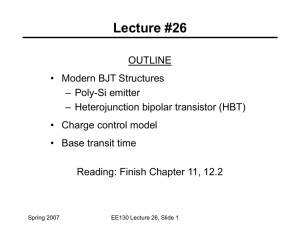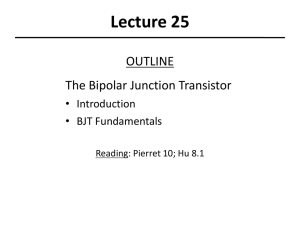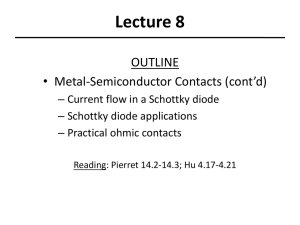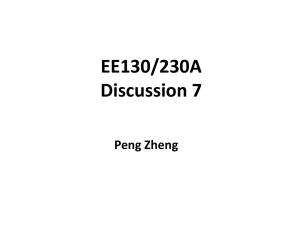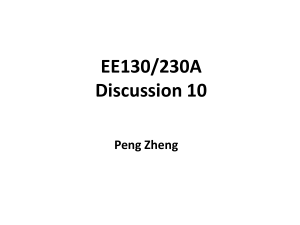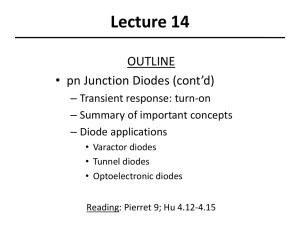Lecture 27 OUTLINE The BJT (cont’d)
advertisement
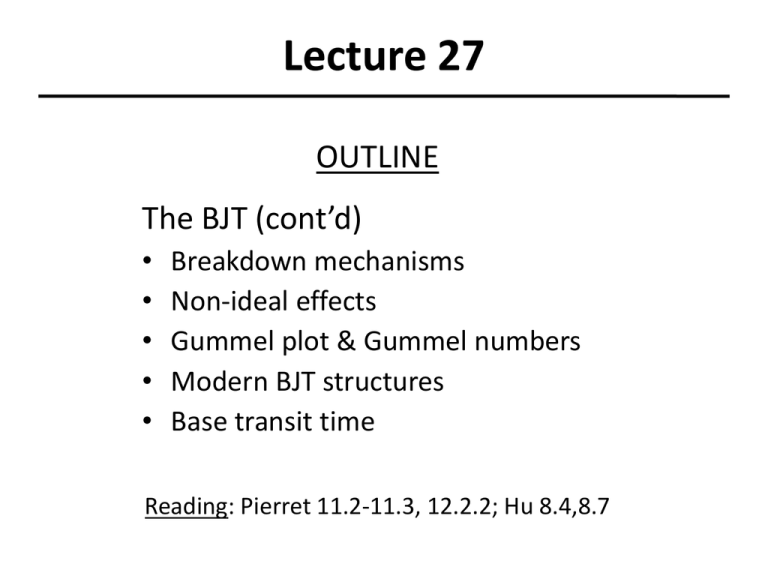
Lecture 27 OUTLINE The BJT (cont’d) • • • • • Breakdown mechanisms Non-ideal effects Gummel plot & Gummel numbers Modern BJT structures Base transit time Reading: Pierret 11.2-11.3, 12.2.2; Hu 8.4,8.7 BJT Breakdown Mechanisms • In the common-emitter configuration, for high output voltage VEC, the output current IC will increase rapidly due to one of two mechanisms: – punch-through – avalanche EE130/230A Fall 2013 Lecture 27, Slide 2 R. F. Pierret, Semiconductor Device Fundamentals, p. 409 Punch-Through E-B and E-B depletion regions in the base touch W = 0 As |VCB| increases, the potential barrier to hole injection decreases and hence IC increases EE130/230A Fall 2013 Lecture 27, Slide 3 R. F. Pierret, Semiconductor Device Fundamentals, Figs. 11.7-11.8 Avalanche Multiplication • Holes are injected into the base [0], then PNP BJT: collected by the B-C junction – Some holes in the B-C depletion region have enough energy to generate EHP [1] • Generated electrons are swept into the base [3], then injected into emitter [4] – Each injected electron results in the injection of IEp/IEn holes from the emitter into the base [0] For each EHP created in the C-B depletion region by impact ionization, (IEp/IEn)+1 > bdc additional holes flow into the collector i.e. carrier multiplication in the C-B depletion region is internally amplified VCE 0 where VCB0 = reverse breakdown voltage of the C-B junction VCB 0 ( b dc 1)1 / m 2 m 6 EE130/230A Fall 2013 Lecture 27, Slide 4 R. F. Pierret, Semiconductor Device Fundamentals, Fig. 11.9 Non-Ideal Effects at Low VEB • In the ideal transistor analysis, thermal R-G currents in the emitter and collector junctions were neglected. I Ep I Ep I En I R G • Under active-mode operation with small VEB, the thermal recombination current is likely to be a dominant component of the base current low emitter efficiency, hence lower gain This limits the application of the BJT for amplification at low voltages. EE130/230A Fall 2013 Lecture 27, Slide 5 Non-Ideal Effects at High VEB • Decrease in bdc at high IC is caused by: – high-level injection qAni2 DB qVEB / kT IC e 1 WN B – series resistance – current crowding EE130/230A Fall 2013 Lecture 27, Slide 6 bdc Gummel Plot and bdc vs. IC bdc EE130/230A Fall 2013 From top to bottom: VBC = 2V, 1V, 0V Lecture 27, Slide 7 C. C. Hu, Modern Semiconductor Devices for Integrated Circuits, Figures 8-8 & 8-9 Gummel Numbers For a uniformly doped base with negligible band-gap narrowing, the base Gummel number is N BW GB DB (total integrated “dose” (#/cm2) of majority carriers in the base, divided by DB) 1 qAni2 DB qVEB / kT qAni2 qVEB / kT IC e 1 e 1 WN B GB Emitter efficiency 1 ni E 2 D N W E B ni B 2 DB N E WE 1 GB 1 GE GE is the emitter Gummel number EE130/230A Fall 2013 Lecture 27, Slide 8 Notice that b dc 1 ni E 2 D N W E B ni B 2 DB N E LE 1 W 2 2 LB GE GB In practice, NB and NE are not uniform, i.e. they are functions of x The more general formulas for the Gummel numbers are W GB 0 W GE 0 EE130/230A Fall 2013 2 ni N B ( x) dx 2 ni B DB ( x) 2 ni N E ( x) dx 2 ni E DE ( x) Lecture 27, Slide 9 Modern NPN BJT Structure Features: • Narrow base • n+ poly-Si emitter • Self-aligned p+ poly-Si base contacts • Lightly-doped collector • Heavily-doped epitaxial subcollector • Shallow trenches and deep trenches filled with SiO2 for electrical isolation C. C. Hu, Modern Semiconductor Devices for Integrated Circuits, Figure 8-22 EE130/230A Fall 2013 Lecture 27, Slide 10 Poly-Si Emitter • bdc is larger for a poly-Si emitter BJT as compared with an allcrystalline emitter BJT, due to reduced dpE(x)/dx at the edge of the emitter depletion region Continuity of hole current in emitter: dpE1 dpE 2 qDE1 qDE 2 dx dx dpE1 DE 2 dpE 2 E 2 dpE 2 dx DE1 dx E1 dx (1poly-Si; 2crystalline Si) EE130/230A Fall 2013 Lecture 27, Slide 11 R. F. Pierret, Semiconductor Device Fundamentals, Fig. 11-18 Emitter Gummel Number w/ Poly-Si Emitter 2 2 ni N E ni N E (WE ) dx 2 WE , poly 2 ni E DE ni E (WE ) DE WE GE 0 WE 0 ni N E ni N E (WE ) dx 2 2 ni E DE ni E (WE ) S p 2 2 where Sp DEpoly/WEpoly is the surface recombination velocity 2 ni WE 1 For a uniformly doped emitter, GE N E 2 niE DE S p qni A qVEB / kT IB e 1 GE 2 EE130/230A Fall 2013 Lecture 27, Slide 12 Emitter Band Gap Narrowing 2 niB N E b dc 2 niE N B To achieve large bdc, NE is typically very large, so that band gap narrowing is significant (ref. Lecture 3, Slide 20). n N c N v e 2 iE EGE / kT niE2 ni2 e EGE / kT EE130/230A Fall 2013 Nc Nve ( EG EGE ) / kT EGE is negligible for NE < 1E18/cm3 N = 1018 cm-3: EG = 35 meV N = 1019 cm-3: EG = 75 meV Lecture 27, Slide 13 Narrow Band Gap (Si1-xGex) Base 2 niB N E b dc 2 niE N B To improve bdc, we can increase niB by using a base material (Si1-xGex) that has a smaller band gap • for x = 0.2, EGB is 0.1 eV This allows a large bdc to be achieved with large NB (even >NE), which is advantageous for • reducing base resistance • increasing Early voltage (VA) EE130/230A Fall 2013 Lecture 27, Slide 14 courtesy of J.D. Cressler (GATech) Heterojunction Bipolar Transistors a) Uniform Ge concentration in base b) Linearly graded Ge concentration in base built-in E-field EE130/230A Fall 2013 Lecture 27, Slide 15 Example: Emitter Band Gap Narrowing If DB = 3DE , WE = 3WB , NB = 1018 cm-3, and niB2 = ni2, find bdc for (a) NE = 1019 cm-3, (b) NE = 1020 cm-3, and (c) NE = 1019 cm-3 and a Si1-xGex base with EGB = 60 meV (a) For NE = 1019 cm-3, EGE 35 meV niE2 ni2 e35meV / 26meV 3.8ni2 1019 ni2 DBWE N E ni2 b dc 9 18 23.6 DEWB N B niE2 10 3.8ni2 (b) For NE = 1020cm-3, EgE 160 meV: niE2 ni2 e160meV / 26meV 470ni2 10 20 ni2 DBWE N E ni2 b dc 9 18 1.9 DEWB N B niE2 10 470ni2 (c) niB2 ni2eE gB / kT EE130/230A Fall 2013 ni2e60meV / 26meV 10ni2 Lecture 27, Slide 16 b F 236 Charge Control Model A PNP BJT biased in the forward-active mode has excess minority-carrier charge QB stored in the quasi-neutral base: pB ( x, t ) pB (0, t )1 Wx qAWpB (0, t ) QB qA pB ( x, t )dx 2 0 W In steady state, EE130/230A Fall 2013 dQB 0 dt Lecture 27, Slide 17 iB dQB QB iB dt B QB B Base Transit Time, t p B ( x, t ) iC qADB x x W qADB p B (0, t ) W qAWpB (0, t ) QB 2 2 DB QB QB iC 2 W t W2 t 2 DB • time required for minority carriers to diffuse across the base • sets the switching speed limit of the transistor EE130/230A Fall 2013 Lecture 27, Slide 18 Relationship between B and t • The time required for one minority carrier to recombine in the base is much longer than the time it takes for a minority carrier to cross the quasi-neutral base region. iB iC QB B QB B b dc t t EE130/230A Fall 2013 Lecture 27, Slide 19 Built-in Base E-Field to Reducet The base transit time can be reduced by building into the base an electric field that aids the flow of minority carriers. 1. Fixed EGB , NB decreases from emitter to collector: E B - C Ec Ef Ev 2. Fixed NB , EGB decreases from emitter to collector: E - B C Ec Ef Ev EE130/230A Fall 2013 Lecture 27, Slide 20 E EXAMPLE: Drift Transistor • Given an npn BJT with W=0.1m and NB=1017cm-3 (n=800cm2/Vs), find t and estimate the base electric field required to reduce t 2 5 2 W 10 cm t 2 ps 2 2 DB 20.026V 800cm / V s W v drift W n t 10 5 cm 6kV / cm 2 12 n t 800cm / V s 2 10 s EE130/230A Fall 2013 W Lecture 27, Slide 21
